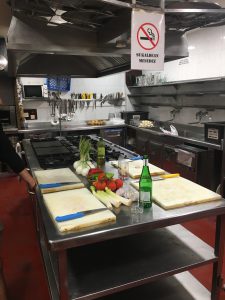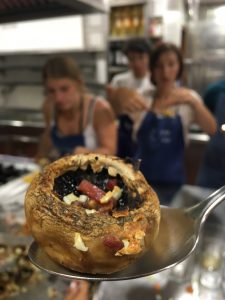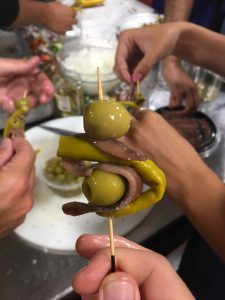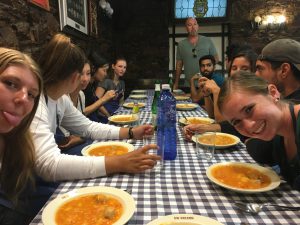Here in San Sebastian, one of the most important cultural experiences one can have is that of food. We eat it every day, and yet here it is less of simply a meal and more part of a larger, social experience of the culture. The food is so deeply intertwined with the culture that it is impossible to separate from all other aspects of the city. Restaurants and bars are always packed with pintxos piled high on the counters and crowded with people, loud and bustling. Whether simply grabbing bocadillos for lunch, enjoying some pintxos in a bar, or sitting down for dinner with our host families, eating is a time where you try new things, share meals with friends and enjoy each other’s company. Especially here in San Sebastian, many of us are trying some different-looking foods for the first time, which can occasionally be scary or overwhelming but is almost always very rewarding. However, only eating the meals is leaving out a very important part of the culinary experience. Preparing food to eat together is a really big part of the culture and it is very different that what we are often used to in America.

Ur-Zaleak kitchen
Last night we walked to Ur-Zaleak, a gastronomic society, which is a private cooking club where members can bring their own ingredients and go use the kitchen to cook for their family and friends, hang out, drink and eat together. The cooking in these clubs is usually done by one or two members and they make enough food for the whole group to enjoy. It is tucked away underground on a hill, with a large kitchen and dining area. When we arrived we were right away given some cider to drink. It is typical of their cooking process to have a drink and be enjoying oneself while preparing the food. Once we all had poured ourselves a glass of cider, we were put to work chopping and dicing vegetables and peeling potatoes.
All together we made five dishes. Three types of pintxos – Gilda (a skewer with peppers, olive and anchovy), tuna with mayonnaise spread on bread, and baked mushrooms with ham and cheese. The pintxos we learned how to make are typical pintxos that we often have seen or eaten in bars, but learning the process behind them adds new flavor and meaning to eating them. The main dish, Marmitako, is a vegetable stew with tuna and potatoes. Finally for dessert we made torrijas, sliced bread soaked in cream, sugar and eggs, and then fried and served with caramelized sugar on top and ice cream. We learned how to cut potatoes by breaking them to release the starch, to add to the creaminess of the stew, and we were amazed by the making of mayonnaise by emulsification. We were seeing an entirely different side of the food we had been consuming on a regular basis.

Champis Rellenos – Mushrooms with ham and cheese

Gilda – Peppers, Olives and Anchovy
This Basque style of cooking is very different than what I was used to. Not a single measuring cup was used, our cooking teacher simply added ingredients as he saw fit. A couple eggs here, some vinegar there. “You never have to be afraid of cooking, just do it your way,” he said. This illustrates a very detailed picture of the food culture here – cooking is more about enjoying the process together with friends than about getting it exactly right. It also speaks to how no two dishes will ever turn out exactly the same, which adds to the excitement of trying new things. When cooking back at home, there is a more precise, methodical manner that everything must be done. Here, however, they cook a little, drink a little, smoke a little, chop some more ingredients, cook a bit more. There is no rush, no stress, no method to the relaxed disorder. It is as if the more the chefs are enjoying themselves cooking, the better the food will taste. And it is easy to believe this may well be true, considering how delicious each and every bite was.

Enjoying our Marmitako together
Throughout the evening, while we were cooking together, and afterwards as we enjoyed the food we had made, the conversation, chatter, and laughter never once died down. Being a part of the cooking process was not only a lot of fun, but it made enjoying the food together afterwards so much more meaningful. We had worked hard together to prepare these dishes and the experience of cooking together simply added to the flavor of the food itself. We learned that eating is only half of the culinary experience. This new knowledge that we learned is a just a small piece of the city and culture that we can bring home to share with our families and friends.
